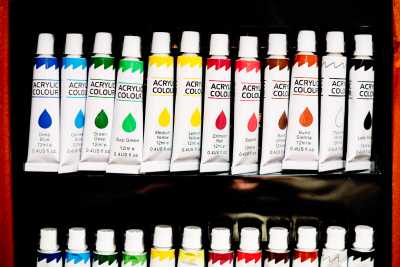Acrylic paint is a water-based synthetic polymer. It was first created in the 1930s and has since become one of the most popular types of paint, due to its versatility and ease of use.
Acrylic paint can be used on a variety of surfaces, including canvas, wood, metal, and glass. It dries quickly and can be thinned with water if necessary. Acrylic paint is also safe for skin, as it is non-toxic and does not contain any harmful chemicals.
The Dangers of Other Paints

While acrylic paint is safe for skin, there are some other types of paint that are not. Oil-based paints, for example, can be extremely dangerous if they come into contact with skin. Oil-based paints contain solvents that can be easily absorbed by the skin. These solvents can then enter the bloodstream and cause serious health problems. Water-based oil paints are slightly less dangerous, but they should still be avoided if possible.
Latex paints are another type of paint that can be harmful to skin. Latex paints contain chemicals that can cause an allergic reaction if they come into contact with skin. If you experience any redness, itching, or swelling after coming into contact with latex paint, wash the area immediately with soap and water and seek medical attention if necessary.
Why Acrylic Paint is Safe for Skin
Acrylic paint is safe for skin because it does not contain any harmful chemicals. The only ingredient in acrylic paint that could possibly be harmful is titanium dioxide, which is a white pigment used to color the paint.
Titanium dioxide is a known irritant, but it is only dangerous if it is inhaled in large quantities. When used in small amounts, such as in acrylic paint, it poses no danger to human health.
If you’re looking for a type of paint that is safe for skin, look no further than acrylic paint! Acrylic paint is non-toxic and does not contain any harmful chemicals. It is also easy to use and dries quickly. So grab a brush and get painting!
Is Watercolor Paint Safe for Skin ?
Many people enjoy painting with watercolors, but one question that is often asked is whether or not watercolor paint is safe for skin. The short answer is that it depends on the paint. Some watercolor paints are made with natural ingredients and are safe for skin, while others contain chemicals that can be harmful. It is important to read the labels on the paint to determine what it is made of before using it on your skin.
Types of Watercolor Paints
Watercolor paints can be divided into two broad categories: those made with natural ingredients and those made with synthetic ingredients. Natural watercolor paints are typically made with pigments from minerals, vegetables, or other sources found in nature. Synthetic watercolor paints are made with man-made pigments, which may be derived from chemical substances.
Some watercolor paints may also be labeled “non-toxic” or “hypoallergenic.” These terms have specific meanings when used on labeling products intended for use by children. According to the U.S. Consumer Product Safety Commission, a product that is labeled “non-toxic” must not contain any harmful ingredients, such as lead or mercury. A product that is labeled “hypoallergenic” must not contain any known allergens, such as latex or certain dyes.
Safety Precautions
If you are going to use watercolor paint on your skin, there are some safety precautions you should take. First, test the paint on a small area of skin to see if you have any allergic reaction to it. If you experience any redness, swelling, or itchiness, wash the area immediately with soap and water and do not use the paint again.
Second, avoid getting the paint in your eyes, nose, or mouth. If you do get paint in one of these areas, flush the area immediately with water and seek medical attention if necessary. Third, make sure to wash your hands thoroughly after painting and avoid touching your face or eating until your hands are clean.
Overall, watercolor paints are safe for skin as long as they are non-toxic and hypoallergenic paints without known allergens. However, it is always a good idea to test the paint on a small area of skin first to make sure you are not allergic to it. If you experience any adverse reaction after coming into contact with the paint, wash the area immediately with soap and water and seek medical attention if necessary. When using watercolors, always take precautions to avoid getting the paint in your eyes or mouth and wash your hands thoroughly after painting.
Is Watercolor Paint Safe for Skin ?
Watercolor paint is a popular medium for artists of all levels, from beginner to seasoned professional. Its portability and relatively low cost make it a great option for painting on the go. But one question that we often get asked here at Blick is, “Is watercolor paint safe for skin?” Let’s take a look at what watercolor paint is made of and see if it’s safe to use on skin.
Watercolor paint is made with pigment and a binder, usually gum arabic. The pigment gives the paint its color while the binder helps hold the pigment onto the surface being painted. Some watercolor paints also contain preservatives to help extend their shelf life.
When used as intended—on paper or another porous surface—watercolor paint is safe for skin. The pigments are actually ground-up rocks, minerals, or other natural substances that are chemically inert and won’t react with your skin. And since watercolors are meant to be used with water, they’re not poisonous if ingested. However, we do not recommend eating your painting supplies!
However, when watercolors are used on NON-porous surfaces like skin, they can cause irritation because the pigments are suspended in a gum arabic binder which can be drying to the skin. If you do decide to use watercolors on your skin, we recommend using them sparingly and avoiding contact with mucous membranes like eyes and lips. It’s also a good idea to test a small patch of skin first to make sure you don’t have an allergic reaction to the paint or binder.
In conclusion, watercolor paint is safe for skin when used as intended—on paper or another porous surface. However, when used on NON-porous surfaces like skin, they can cause irritation because the pigments are suspended in a gum arabic binder which can be drying to the skin.
If you do decide to use watercolors on your skin, we recommend using them sparingly and avoiding contact with mucous membranes like eyes and lips. Have you ever used watercolors on your skin? Let us know in the comments below !
